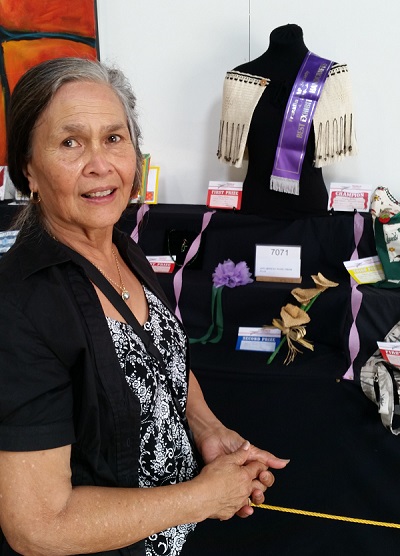My Weaving Journey
I was born on the island of Mauke in the Southern Cook Islands. My parents were Mana Strickland, a career educator and my mother Mauariki, a respected weaver and skilled in the design and production of handwork, such as tivaivai and embroidered pillow cases as well as dress making. I have ancestral links with Mataatua through my Mauke side and with Tainui through my Aitutaki side.
In 1946 we moved to Pukapuka where my father was appointed to the position of headteacher. It was there from a young age I recall watching the Mamas collecting and preparing pandanus for their weaving. The mamas would often work together and enjoyed each other’s company as they produced large mats. The coconut palms were also woven to provide a rain proof thatched roof for many of the traditional type homes. Some of the finer coconut fronds produced rito, produced by stripping the coconut leaf, then boiling to produce a delicate white fibre used in finely woven hats and baskets. I was fascinated by the way the Mamas worked and the beautiful natural products they used and what they were able to produce.
I observed my father, making rope for lashing the outriggers to his canoe. The process involved the short fibres of the coconut husk being twined to make a longer piece of rope (sinnet).
In 1949 we returned to Rarotonga with Dad taking up a teaching position there. Our first home was a home made from traditional materials so I was able to learn quickly the art of plaiting coconut fronds for the roof. In addition we used plaited coconut palms for screening the cooking house. At school and at home I loved the opportunities to continue learning more about handwork using environmental resources. I recall making hula skirts from kiriau, the bark of the au tree as well as making kete (baskets). Growing up in the Cook Islands was a haven for handcrafts and for those young girls interested and with patience there were always Mamas prepared to teach them. I was fortunate to have my own Mama on hand as well and so willing to share her talents.
After spending my early years, involved in education both as a learner and later as a teacher and continuing to refine my handwork skills life changed. In 1969, I left behind my homeland with my husband, John for a new life in New Zealand. While initially I continued my handwork it was of a different nature. At that time, flax weaving was not the focus of school night classes so I had to contend myself learning new skills such as making cane products, macramé, ceramics, lead-light making, cake decorating, pottery, marbling, doll making, mosaics, and papier mache. In addition, in 1978, I attended Auckland College of Education to meet New Zealand teaching requirements.
It was while at Rawene in the mid 1970’s that I met an old kuia who was interested in some of my Cook Islands’ weaving and in return was happy to share with me her flax weaving talents. I was intrigued with the likeness of flax weaving and pandanus weaving and certainly learned a lot from her.
It wasn’t until early 2000 that I found my calling again when I found flax weaving classes being run in Hamilton. It was that opportunity which allowed me to use new fibres and the realisation that many of the processes, using different fibres, were similar to the ones I had learnt when growing up in the Cook Islands. I was happy to sit for hours, when not teaching young children, and put into practice the knowledge shared by a respected Tainui weaver.
In 2007 after moving to Pukekohe, I enrolled in Raranga classes with Te Wanaanga o Aotearoa. In my fourth year of weaving I was awarded my Bachelor of Visual Arts (Maori). The four years of courses were enlightening and allowed me to develop a range of skills using flax. These included kete making, mat making, tukutuku panels and the fine art of muka korowai making. I also used contemporary materials for making korowai as well as being in a position to carry out a detailed study of the production of rito from coconut palms in the Cook Islands and then made handcrafts using rito. Opportunities were also provided to gain a better understanding of the different species of flax and how some were better than others for particular weaving creations. Changing the composition of flax through boiling and dyeing added another dimension to my knowledge.
Since completing my degree, I have continued to weave and have produced articles for exhibitions as well as gifts. My real passion is weaving muka and while the process is time consuming, the end product reflects the beauty of the white, inner fibre of flax.
I have also run weaving classes at Mataatua Marae, Franklin Arts Centre and Papakura Arts Centre. I have supported Mataatua Marae with school visits to the marae as well as visiting primary, intermediate and secondary schools to involve students in different aspects of weaving.
In recent times, I have made a number of wahakura at weaving hui as well as making a number at home.